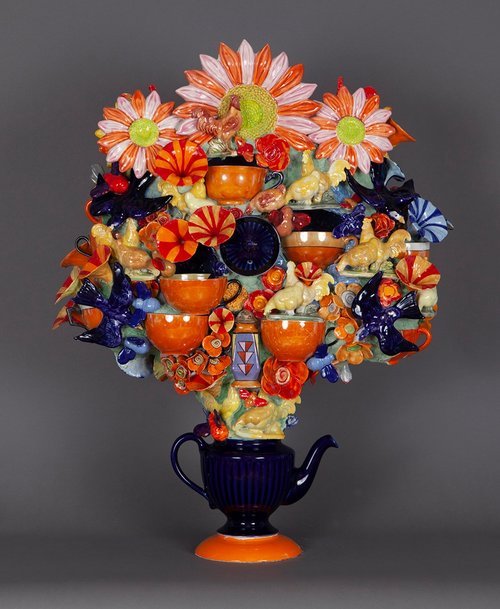














Your Custom Text Here
With ceramic teapots, sunflowers, bread plates, and bunnies piled up in masses of buoyant optimism, Joan Bankemper transforms traditionally modest tableware into miniature architectural follies. Each of her sculptures is created with hundreds of ceramics from molds she has collected. Bankemper’s work is influenced by the Spanish architect Antoni Gaudi (1852-1926), whose ceramic encrusted church, the Sagrada Familia, in Barcelona, is one of the most striking monuments conceived in the late 19th century.
Capturing the exuberant colors and forms of the natural world, Bankemper crams a whole garden into a teapot. In works like “Splitting Orange Bee Mandala”, the artist uses the teapot, symbol of domestic comforts and nourishment, as the base of her work with the most fantastical creativity rising from it - the lid of domesticity is literally blown off. In Hindu and Buddhist symbolism, a “mandala” is a geometric figure representing the universe. For the hard- working bee, these flowers, to which it travel to fertilize and receive food, represent the outer limits of the universe.
Victorian women embraced china painting as a means of economic support and to express their talent and good taste. Here, the artist has taken the electric aesthetic of Victorian ceramics to an artistic extreme. In Suzanna's Garden of Earthy delights, she makes reference to Hieronymus Bosch’s Renaissance triptych that highlights the most bizarre indulgences of the flesh. Her works are like an acid trip of floral wonderland-the wilder side of every “domestic Goddess.”
-Bartholomew F. Bland, Curator of “The Neo-Victorians: Contemporary Artists Revive Gilded-Age Glamour” at the Hudson River Museum 2018
With ceramic teapots, sunflowers, bread plates, and bunnies piled up in masses of buoyant optimism, Joan Bankemper transforms traditionally modest tableware into miniature architectural follies. Each of her sculptures is created with hundreds of ceramics from molds she has collected. Bankemper’s work is influenced by the Spanish architect Antoni Gaudi (1852-1926), whose ceramic encrusted church, the Sagrada Familia, in Barcelona, is one of the most striking monuments conceived in the late 19th century.
Capturing the exuberant colors and forms of the natural world, Bankemper crams a whole garden into a teapot. In works like “Splitting Orange Bee Mandala”, the artist uses the teapot, symbol of domestic comforts and nourishment, as the base of her work with the most fantastical creativity rising from it - the lid of domesticity is literally blown off. In Hindu and Buddhist symbolism, a “mandala” is a geometric figure representing the universe. For the hard- working bee, these flowers, to which it travel to fertilize and receive food, represent the outer limits of the universe.
Victorian women embraced china painting as a means of economic support and to express their talent and good taste. Here, the artist has taken the electric aesthetic of Victorian ceramics to an artistic extreme. In Suzanna's Garden of Earthy delights, she makes reference to Hieronymus Bosch’s Renaissance triptych that highlights the most bizarre indulgences of the flesh. Her works are like an acid trip of floral wonderland-the wilder side of every “domestic Goddess.”
-Bartholomew F. Bland, Curator of “The Neo-Victorians: Contemporary Artists Revive Gilded-Age Glamour” at the Hudson River Museum 2018
Red Delicious, 2019
Ceramic
25 x 22 x 12”
Garrison, 2019
Ceramic
26 x 21 x 9”
Emma, 2019
Ceramic
29 x 21 x 12”
Violet, 2019
Ceramic
28 x 22 x 13”
Pimlico, 2018
Ceramic
41 1/2 x 37 x 10”
Itinerant Players, 2018
Ceramic
36 1/2 x 27 1/2 x 12”
Serina, 2018
Ceramic
26 x 15 x 12”
Black Meadow, 2017-18
Ceramic
33 1/2 x 21 x 12”
Splitting Orange Bee Mandala, 2017
Ceramic
32 x 22 x 10”
Forget Me Not, 2017
Ceramic
21 x 16 x 8”
Rue de Rivoli, 2017-18
Ceramic
28 x 21 x 12”
Wicker Park, 2017
Ceramic
38 x 21 x 12”
Bird, Bee, and Tulip Mandala, 2016
Ceramic
28 x 21 x 11 1/2”
Jardin Du Roi, 2016
Ceramic
33 x 18 x 10”
Black Madonna, 2011
Ceramic
29 x 25 x 25”